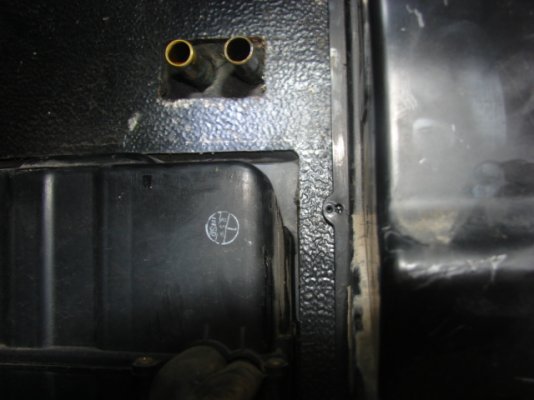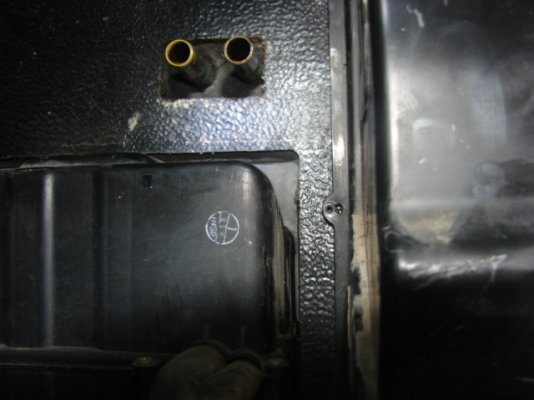As I was doing routine maintenance I removed the heater core inlet and outlet heater hoses located (under the hood )upper left firewall. Decided to replace aged hoses..as I removed the other end of hoses I lost track of which hose connected to the heater core inlet and outlet. They are not marked . Can anyone with a P 32 series chevy chassis identify which is inlet which would be the long hose connected to engine thermostat. or outlet which would be connected to the radiator. Please identify the heater core inlet outlet connection...pic attached Thanks
You are using an out of date browser. It may not display this or other websites correctly.
You should upgrade or use an alternative browser.
You should upgrade or use an alternative browser.
1998 Fleetwood southwind 32V Please HELP!
- Thread starter Oran42348
- Start date
The friendliest place on the web for anyone with an RV or an interest in RVing!
If you have answers, please help by responding to the unanswered posts.
If you have answers, please help by responding to the unanswered posts.
BoomerD
Well-known member
I could be mistaken...and it certainly wouldn't be the first time...but I don't think the flow direction really matters in the heater core. Flow SHOULD go from the head into the heater core, then return to the water pump.
The only info I can find is here:
http://gmupfitter.com/files/media/photo/177/1999_LD_P3242Chassis.PDF
Page 42, but that is for diesel engines... :shrug: The basic plumbing SHOULD still be the same. I;d connect the supply (head) hose to whichever fitting has the most direct route.
The only info I can find is here:
http://gmupfitter.com/files/media/photo/177/1999_LD_P3242Chassis.PDF
Page 42, but that is for diesel engines... :shrug: The basic plumbing SHOULD still be the same. I;d connect the supply (head) hose to whichever fitting has the most direct route.
boatbuilder
Well-known member
While in theory the flow direction matters for heat transfer, in all practicality it will not make a difference. The only time it would is if you have a valve in the system like some of the older Chrysler products had.
steve407
Well-known member
My 2015 Fleetwood Storm had that problem with 18 wheelers pushing me around. I used to feel like I was being bullied in school by them. I put a Safe-T-Plus on and it helped but still wasn't quite right. While in Atlanta, I made arrangements to stop by Safe-T-Plus HQ, told them my problem and they were awesome. They put a new one (one size larger) on for free, took it out and aligned it for me all at no charge and gave me two hats for the wife and I to wear! I can drive that Storm one handed now, and even when a semi blows by I feel only a tiny push, then a tiny pull, and it's over. It made an incredible difference. I wear their free hats all the time to advertise for them because of how much help they (and their product) was to me. And no -- I'm NOT endorsed for this review! I DO recommend getting the bigger of the two F53 size units, however.
Steve
Steve
Rene T
Site Team
steve407 said:My 2015 Fleetwood Storm had that problem with 18 wheelers pushing me around. I used to feel like I was being bullied in school by them. I put a Safe-T-Plus on and it helped but still wasn't quite right. While in Atlanta, I made arrangements to stop by Safe-T-Plus HQ, told them my problem and they were awesome. They put a new one (one size larger) on for free, took it out and aligned it for me all at no charge and gave me two hats for the wife and I to wear! I can drive that Storm one handed now, and even when a semi blows by I feel only a tiny push, then a tiny pull, and it's over. It made an incredible difference. I wear their free hats all the time to advertise for them because of how much help they (and their product) was to me. And no -- I'm NOT endorsed for this review! I DO recommend getting the bigger of the two F53 size units, however.
Steve
WHOWWWWWWW. Talk about highjacking!!! ;D
boatbuilder said:While in theory the flow direction matters for heat transfer, in all practicality it will not make a difference. The only time it would is if you have a valve in the system like some of the older Chrysler products had.
my thoughts exactly until I read the service manual.( note:The heater hose routing should not be altered from the system.The hot water enters the bottom of the heater core and exits out the top for better heat dissipation.) question is which of the connections in the original post picture attachment enters the bottom of the heater core.
BoomerD said:I could be mistaken...and it certainly wouldn't be the first time...but I don't think the flow direction really matters in the heater core. Flow SHOULD go from the head into the heater core, then return to the water pump.
The only info I can find is here:
http://gmupfitter.com/files/media/photo/177/1999_LD_P3242Chassis.PDF
Page 42, but that is for diesel engines... :shrug: The basic plumbing SHOULD still be the same. I;d connect the supply (head) hose to whichever fitting has the most direct route.
Since I don't know which of the two is directly connected to the bottom of the heater core question still remains ,which of these two connections goes to the bottom of the heater core?
Thanks all ...issue resolved!...the inlet is on the left and outlet on the right. I was able to determine that the radiator hose connected to the right core connection by the knife marking on outlet nipple when I split the end for removal. the other was obviously the inlet from the thermostst..THANKS AGAIN
Attachments
Rene T
Site Team
Glad you solved it.
I think the inlet should enter the heater core at the bottom because you want all the air to get purged out when filling. If you fill from the top, there's a chance you won't get all the air out and it won't be efficient.
I think the inlet should enter the heater core at the bottom because you want all the air to get purged out when filling. If you fill from the top, there's a chance you won't get all the air out and it won't be efficient.
R
rls7201
Guest
Oran42348 said:Thanks all ...issue resolved!...the inlet is on the left and outlet on the right. I was able to determine that the radiator hose connected to the right core connection by the knife marking on outlet nipple when I split the end for removal. the other was obviously the inlet from the thermostst..THANKS AGAIN
Just an FYI: Both of those nipples go through the fire wall and both attach to the bottom of the heater core, on either side. The flow pattern is up one side and down the other. It make no difference which way the hoses are connected. Denso is the manufacture of your HVAC system.
Richard


